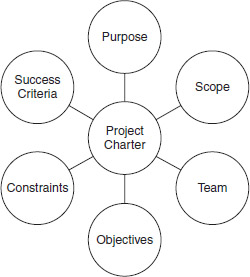Activity 1
Project charter
Overview
The Project Management Institute (PMI) (2017) defines a project charter as ‘a document issued by senior management that formally authorises the work of the project to begin (or continue) and gives the project manager authority to do his job’. It is regarded as an essential precursor to the planning process and part of the formal initiation of the category process.
Sometimes incorrectly referred to as a ‘team charter’, the project charter’s precise format varies from situation to situation and from team to team. The final approved document formally initiates the project. In effect it is a simpler visual representation of a project initiation document (PID).
The project charter is regarded as an excellent way of clarifying direction and encouraging understanding and buy-in from key stakeholders. It is, in essence, a ‘road map’ which helps all those involved understand the direction and speed of travel while journeying to the final destination.
Elements
A typical project charter will have the following structure:
- Purpose – The reason for initiating the category management process. It can provide a platform for common understanding and vision of what the final delivery might be.
- Scope – Identifies what is in scope and what is out of scope. Defining the scope is critical in order to avoid making false assumptions about the project. This will include defining the category of expenditure.
- Team – A list of category team members, their roles and time allocations (i.e. full or part time). Some key members may also have their responsibilities defined. This normally relates to the team leader and team sponsor.
- Objectives – A clear statement of how the team intends to reach its end goal through a description of the objectives to be achieved. Objectives should be written at a low level so that they can be evaluated at the conclusion of a project to see whether they were achieved or not. A well-worded objective will be SMART (specific, measurable, attainable/achievable, realistic and time bound).
- Constraints – This is an opportunity to explore potential issues, roadblocks and risks to category delivery.
- Success criteria – A list of criteria that must be met in order to evidence that the category management process has delivered its vision. Some project charters like to develop additional success measures with reference to softer elements such as ‘team learning’ and ‘team dynamics’.
- Budget – From time to time category team expenditure may be required (e.g. off-site meetings, team building, visiting reference sites). An estimate of costs will give a fuller picture to those sponsoring the category management, and therefore a reward-versus-effort equation can be made.
- Approval process – The appropriate approval process should be ascertained, together with the relevant gateways and associated timings, so that the team can estimate the relevant timings to manage the category, as well as resources and potential key dates.
So what?
By using the project charter as a method of initiation, the category team are following best practice when it comes to ‘kicking off’ waves of activity. In effect, this formal approach helps establish robust project management procedures to the category management discipline.
The development of a project charter necessitates the early engagement and cooperation of key stakeholders in order to gain consensus and approval, and ergo becomes a useful mechanism for identifying participants’ expectations and capturing potential group organisational issues at the start of cross-functional category processes.
Category management application
- Forms a means of formal category project sign-off and approval
- Provides a vision for the category team
- Provides a mechanism for clarifying understanding of team objectives and goals
- Educates others across the business as to the category project’s purpose
- Provides an initial estimate of resource allocation that can be made
Limitations
Investing time up front to develop the project charter reduces confusion later on. It enables the team to get it right first time. However, due to increasingly time-pressured working environments, there can be a temptation to complete the document without the support or assistance of the business. Of course, this approach is fundamentally flawed, as one of the main functions of the project charter is to ensure group consensus on ways of working, scope and so forth.
There is also confusion between the discreet roles of the team charter versus the project charter, and either due to misunderstanding or time pressures, these templates are often merged into one, or one or the other is omitted from the category management process.
Furthermore, there is a temptation to treat category management as a discrete project that has a specific end point. While this can be useful for managing various iterations of the category management process, the reality is that category management should be a continuous cycle of activity rather than a discrete project.
Template
The following template can be used to assist with the formation of a category project:
- Template 1: Project charter
